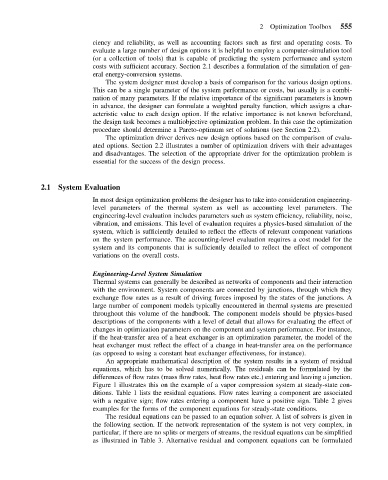Page 566 - Mechanical Engineers' Handbook (Volume 4)
P. 566
2 Optimization Toolbox 555
ciency and reliability, as well as accounting factors such as first and operating costs. To
evaluate a large number of design options it is helpful to employ a computer-simulation tool
(or a collection of tools) that is capable of predicting the system performance and system
costs with sufficient accuracy. Section 2.1 describes a formulation of the simulation of gen-
eral energy-conversion systems.
The system designer must develop a basis of comparison for the various design options.
This can be a single parameter of the system performance or costs, but usually is a combi-
nation of many parameters. If the relative importance of the significant parameters is known
in advance, the designer can formulate a weighted penalty function, which assigns a char-
acteristic value to each design option. If the relative importance is not known beforehand,
the design task becomes a multiobjective optimization problem. In this case the optimization
procedure should determine a Pareto-optimum set of solutions (see Section 2.2).
The optimization driver derives new design options based on the comparison of evalu-
ated options. Section 2.2 illustrates a number of optimization drivers with their advantages
and disadvantages. The selection of the appropriate driver for the optimization problem is
essential for the success of the design process.
2.1 System Evaluation
In most design optimization problems the designer has to take into consideration engineering-
level parameters of the thermal system as well as accounting level parameters. The
engineering-level evaluation includes parameters such as system efficiency, reliability, noise,
vibration, and emissions. This level of evaluation requires a physics-based simulation of the
system, which is sufficiently detailed to reflect the effects of relevant component variations
on the system performance. The accounting-level evaluation requires a cost model for the
system and its components that is sufficiently detailed to reflect the effect of component
variations on the overall costs.
Engineering-Level System Simulation
Thermal systems can generally be described as networks of components and their interaction
with the environment. System components are connected by junctions, through which they
exchange flow rates as a result of driving forces imposed by the states of the junctions. A
large number of component models typically encountered in thermal systems are presented
throughout this volume of the handbook. The component models should be physics-based
descriptions of the components with a level of detail that allows for evaluating the effect of
changes in optimization parameters on the component and system performance. For instance,
if the heat-transfer area of a heat exchanger is an optimization parameter, the model of the
heat exchanger must reflect the effect of a change in heat-transfer area on the performance
(as opposed to using a constant heat exchanger effectiveness, for instance).
An appropriate mathematical description of the system results in a system of residual
equations, which has to be solved numerically. The residuals can be formulated by the
differences of flow rates (mass flow rates, heat flow rates etc.) entering and leaving a junction.
Figure 1 illustrates this on the example of a vapor compression system at steady-state con-
ditions. Table 1 lists the residual equations. Flow rates leaving a component are associated
with a negative sign; flow rates entering a component have a positive sign. Table 2 gives
examples for the forms of the component equations for steady-state conditions.
The residual equations can be passed to an equation solver. A list of solvers is given in
the following section. If the network representation of the system is not very complex, in
particular, if there are no splits or mergers of streams, the residual equations can be simplified
as illustrated in Table 3. Alternative residual and component equations can be formulated

